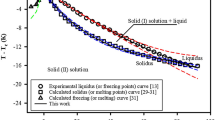Abstract
Ehrenfest classification of phase transitions discerns between two categories: first-order transitions obeying Clapeyron equation and second-order transitions that should obey Ehrenfest equations. Considering the equilibrium phase diagram of binary systems with lentiform two-phase field and with bell-shaped miscibility gap, the corresponding Ehrenfest equations applicable for calorimetry and dilatometry are derived.





Similar content being viewed by others
References
Berthelot M. Essai de Mecanique Chimique fondee sur la Thermochimie, vol. 2. Paris: Dunod; 1879.
Lehmann O. Molekularphysik, vol. 2. Leipzig: Engelmann; 1888. p. 398–415.
Ehrenfest P, Phasenumwandlungen im üblichen und erweiterten Sinn, classifiziert nach dem entsprechen-den Singularitäten des thermodynamischen Potentiales.” Verhandlingen der Koninklijke Akademie van Wetenschappen Amsterdam 1933;36: 153–157; Communications from the Physical Laboratory of the University of Leiden, Supplement No. 75b (1933).
Keesom WH, de Haas WJ, Die Umwandlung flüssiges Helium I-Helium II unter Druck. Verhandlingen der Koninklijke Akademie van Wetenschappen Amsterdam 1932;34:605; Communications from the Physical Laboratory of the University of Leiden, Communication No. 216b (1932).
Clapeyron E, Puissance motrice de la chaleur, Journal de l’École Royale Polytechnique, Vingt-troisième cahier, 1834;Tome XIV:153–190.
Clausius R, Über die bewegende Kraft der Wärme und die Gesetze, welche sich daraus für die Wärmelehre selbst ableiten lassen. Pogg Ann (Annalen der Physik) 1850;79: 368–397 + 500–524 (p. 372).
L’Hospital G de, L’analyse des infiniment petits pour l’intelligence des lignes courbes. 1696.
Maxwell JC. Theory of heat. London: Longmans, Green, and Co; 1871. p. 165–8.
Rutgers AJ. Note on supraconductivity I. Physica. 1934;2:1055–8.
Landau LD. On the theory of phase transitions. Zh Eksp Teor Fiz. 1937;7:19–32.
Onsager L. Crystal statistics. I. A two-dimensional model with an order-disorder transition. Phys Rev. 1944;65:117–49.
Tisza L. On the general theory of phase transitions. In: Smoluchowski R, et al., editors. Phase transitions in solids (Symposium at Cornell University, August, 1948). New York: Wiley; 1951. p. 1–37.
Callen HB. Thermodynamics. New York: Wiley; 1960.
Tisza L. The thermodynamics of phase equilibrium. Ann Phys. 1961;13:1–92.
Pippard AB. Elements of classical thermodynamics. Cambridge: Cambridge University Press; 1957.
Jaeger G. The Ehrenfest classification of phase transitions: introduction and evolution. Arch Hist Exact Sci. 1998;53:51–81.
The Great Soviet Encyclopedia 1979. http://encyclopedia2.thefreedictionary.com. Accessed 15 Sept 2013; http://slovari.yandex.ru/~книги/БCЭ/Фaзoвыйпepexoд/. Accessed 3 Nov 2014.
Matolcsi T. On the classification of phase transitions. Z Angew Math Phys. 1996;47:837–57.
Holba P, Equilibrium background of gradual transitions and Ehrenfest equations in binary system. Book of contributions (4th Joint Czech-Hungarian-Polish-Slovak Thermoanalytical conference. Pardubice 24–27. June 2013) pp.56–59. ISBN 978-80-7395-603-5.
Holba P, Equilibrium background of processes initiated by heating, Ehrenfest classification of phase transitions and its applicability on thermal analysis. Abstracts of XIV International Conference on Thermal Analysis and Calorimetry in Russia (RTAC-2013) 23–28 September, 2013, Saint-Petersburg, Russia. St-Petersburg State Polytechnical University, 2013. p. 6.
Holba P, Ehrenfestovy rovnice a termická analýza. In: Proceedings of 36th KALSEM (International Slovak and Czech Calorimetric Seminary, Trenčianské Teplice, Slovakia, May 26-30th 2014) pp. 19-22, Univerzita Pardubice 2014, ISBN 978-80-7395-784-1 (in Czech).
Holba P, Šesták J, Kinetics with Regard to the Equilibrium of Processes Studied by Non-Isothermal Techniques, Zeit. physik. Chem. 1972;N.F.80 [1/2]:1–20.
Holba P. Equilibrium background of processes initiated by heating and Ehrenfest’s classification of phase transitions. In: Šesták J, Šimon P, editors. Thermal Analysis of Micro. Springer, Heidelberg: Nano- and Non-Crystalline Materials; 2003. p. 29–52.
Hillert M. Phase equilibria, phase diagrams and phase transformation. Their thermodynamic basis. Cambridge: Cambridge University Press; 1998.
Rycerz L. Practical remarks concerning phase diagrams determination on the basis of DSC measurement. J Therm Anal Calorim. 2013;113:231–8.
Acknowledgements
The result was developed within the CENTEM project, Reg. No. CZ.1.05/2.1.00/03.0088, co-funded by the ERDF as part of the Ministry of Education, Youth and Sports OP RDI programme.
Author information
Authors and Affiliations
Corresponding author
Rights and permissions
About this article
Cite this article
Holba, P. Ehrenfest equations for calorimetry and dilatometry. J Therm Anal Calorim 120, 175–181 (2015). https://doi.org/10.1007/s10973-015-4406-6
Received:
Accepted:
Published:
Issue Date:
DOI: https://doi.org/10.1007/s10973-015-4406-6




